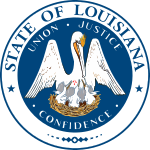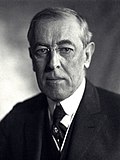| |||||||||||||||||||||||||||||||||
| |||||||||||||||||||||||||||||||||
 Parish Results
| |||||||||||||||||||||||||||||||||
| |||||||||||||||||||||||||||||||||
| Elections in Louisiana |
|---|
 |
|
|
The 1916 United States presidential election in Louisiana took place on November 7, 1916 as part of the 1916 United States presidential election. Voters chose ten representatives, or electors to the Electoral College, who voted for president and vice president.
Ever since the passage of a new constitution in 1898, Louisiana had been a one-party state dominated by the Democratic Party. The Republican Party became moribund due to the disenfranchisement of blacks and the complete absence of other support bases as Louisiana completely lacked upland or German refugee whites opposed to secession.[1] Despite this absolute single-party dominance, non-partisan tendencies remained strong among wealthy sugar planters in Acadiana and within the business elite of New Orleans.[2]
Following disfranchisement, the state’s politics became dominated by the Choctaw Club of Louisiana, generally called the “Old Regulars”. This political machine was based in New Orleans and united with Black Belt cotton planters.[3] Opposition emerged in the north and west of the state vis the Socialist Party, who elected a few officials in Winn Parish between 1908 and 1912,[4] and by the Industrial Workers of the World in the lumbering parishes of Imperial Calcasieu.[5] This opposition was mortally weakened almost immediately after the 1912 election by the unresolved conflict between electoral and antipolitical strategies for reform.[6] Stronger opposition came via the Progressive movement soon after, although this time in the southern sugarcane-growing parishes, where conflicts with President Wilson’s Underwood-Simmons Act[7] even allowed a Progressive Party member in Whitmell P. Martin[a] to be elected to the Third Congressional District in 1914.
Whereas Theodore Roosevelt’s Progressive Party disintegrated after the 1914 elections in most of the United States, in Louisiana it had a brief revival during the following election cycle as John M. Parker, a long-time business progressive[8] and wealthy landowner[9] ran for governor against Democratic primary winner Ruffin G. Pleasant in April 1916, and at the same time sixteen Progressives were elected to the state legislature, the first time any non-Democrat had been so elected since before the 1898 Constitution. Despite carrying sixteen parishes – mostly in the sugar belt – Parker carried only 38 percent of the vote.[10]
However, this would be the high point of the Progressive movement in Louisiana. Parker was nominated for vice-president by the national Progressive Party, but when Roosevelt declined the presidential place on this ticket and endorsed national Republican nominee Charles Evans Hughes, the top spot was left empty and Parker endorsed incumbent president Wilson.[10] Despite this, opposition to Wilson’s tariff policy in the sugar parishes was sufficient that the Progressive ticket did very well in this area, becoming the first non-Democrat to carry any Louisiana parish since 1900.
- ^ Phillips, Kevin P. The Emerging Republican Majority. pp. 208, 210. ISBN 9780691163246.
- ^ Schott, Matthew J. (Summer 1979). "Progressives against Democracy: Electoral Reform in Louisiana, 1894-1921". Louisiana History: The Journal of the Louisiana Historical Association. 20 (3): 247–260.
- ^ Wall, Bennett H.; Rodriguez, John C. Louisiana: A History. pp. 274–275. ISBN 1118619293.
- ^ Williams, Thomas Harry (1981). Huey Long. New York City: Vintage Books. pp. 44–45. ISBN 0394747909.
- ^ Renshaw, Patrick (1968). The Wobblies: The Story of Syndicalism in the United States. Garden City, New York: Anchor Books. pp. 76, 120–121.
- ^ Renshaw (1968). The Wobblies, pp. 122-123
- ^ Collin, Richard H. (Winter 1971). "Theodore Roosevelt's Visit to New Orleans and the Progressive Campaign of 1914". Louisiana History: The Journal of the Louisiana Historical Association. 12 (1): 5–19.
- ^ Schott, Matthew J. (Spring 1983). "The New Orleans Machine and Progressivism". Louisiana History: The Journal of the Louisiana Historical Association. 24 (2): 141–153.
- ^ Hair, William Ivy. The Kingfish and His Realm. ISBN 0807145661.
- ^ a b Cowan, Walter Greaves; McGuire, Jack B. Louisiana Governors: Rulers, Rascals, and Reformers. p. 151. ISBN 1604733209.
Cite error: There are <ref group=lower-alpha> tags or {{efn}} templates on this page, but the references will not show without a {{reflist|group=lower-alpha}} template or {{notelist}} template (see the help page).
© MMXXIII Rich X Search. We shall prevail. All rights reserved. Rich X Search



